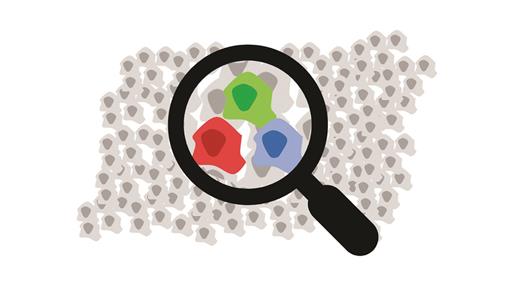Internal tandem duplications in the FMS-like tyrosine kinase 3 (FLT3-ITD) in acute myeloid leukemia (AML) give rise to constitutive tyrosine kinase signaling, leading to chemotherapy resistance and adverse clinical prognosis.1 FLT3-ITD is found in approximately 25 percent of patients with AML.2 Given the impact and frequency of this mutation, small molecules that inhibit FLT3 tyrosine kinase have been examined in multiple clinical trials, with demonstrated clinical efficacy and improved overall survival alone; they have also been used in combination with induction chemotherapy. The latter trials include the pivotal, phase III, placebo-controlled RATIFY study3 and the phase II AMLSG 16-10 trials,4 which specifically examined the efficacy of midostaurin when used together with chemotherapy in FLT3-mutant AML. As a result of these studies, midostaurin received approval for the treatment of FLT3-mutant AML; however, relapsed or refractory disease remains an issue for a significant portion of patients who have dismal long-term outcomes.3,4 Although numerous resistance mechanisms have been described with other FLT3 inhibitors,5,6 a comprehensive study to understand disease relapse after midostaurin plus chemotherapy has not yet been reported.
It is in this setting that Dr. Laura K. Schmalbrock and colleagues aimed to define the mechanism of relapse of FLT3-ITD AML treated with midostaurin and chemotherapy. To achieve this, they analyzed patient sample data from the RATIFY and AMLSG 16-10 studies to first determine whether there was clonal evolution present within the genomic landscape of paired patient samples between diagnosis and relapse. They specifically examined the FLT3-ITD allelic ratio and length of the FLT3 mutation using conventional GeneScan-based testing together with whole-exome sequencing to assess mutation patterns independent of the established FLT3-ITD. The authors were able to demonstrate significant clonal evolution between diagnosis and relapsed AML samples. The chemotherapy-alone group contained a higher rate of clonal stability and mutational patterns that remained relatively persistent. In particular, epigenetic mutations remained relatively stable between diagnosis and relapse. In contrast, under the selective pressure of FLT3 inhibition with midostaurin, there was a higher rate of FLT3-ITD–negative relapse and selection for low allelic ratio FLT3-ITD subclones.
By comparing the distinct patterns of relapse observed in 54 individual patients with FLT3-ITD mutations treated with midostaurin or placebo, the authors were able to delineate three distinct patterns of clonal evolution that were more common after midostaurin plus chemotherapy in combination: 1) acquired mutations in separate signaling pathways in a FLT3-ITD–negative clone, 2) selection of resistant subclones that express an FLT3 mutation, or 3) persistence of the dominant FLT3-ITD clone. The loss of FLT3-ITD clones at relapse implies that on-target pressure from the FLT3 inhibitor selected for clones with growth advantage that was independent of FLT3. These were found in 46 percent of relapse patients and 42 percent of patients with refractory disease. The mutations in this group showed a predominance of mitogen-activated protein kinase (MAPK) signaling pathway mutations, including MAP3K1, FAM53A, and TMPRSS4, and RAS-associated genes. In the second resistance pattern, emergence of a resistant FLT3-mutant subclone was only seen in cases of relapse, suggesting that prolonged exposure to drug was required to select out resistant subclones. In these cases, cooperating genetic mutations (e.g., SRSF2 or RUNX1 mutations) may have facilitated the outgrowth of resistant cells. Finally, the third group of patients had the re-emergence of the dominant FLT3-ITD–mutant clone from diagnosis. This suggests that there was insufficient on-target inhibition or potentially poor adherence to, or tolerance of, midostaurin dosing regimens underlying this relapse. Interestingly, in FLT3-ITD persistent clones found after chemotherapy or combined midostaurin plus chemotherapy, there was enrichment in mutations involving cell cycle regulation, suggesting that this might be an important mechanism of chemotherapy resistance.
In Brief
Overall, the authors were able to demonstrate three distinct patterns of disease resistance in patients with FLT3-ITD AML treated with midostaurin and chemotherapy. These data provide insight into the mechanisms of treatment resistance and offer therapeutic opportunities for combinations to prolong remission by preventing relapse. For example, in the case of resistance that loses FLT3-ITD clones, can we identify a future subset of patients that may be responsive to therapies targeting MAPK pathways? Or can sequential genomic screening pre-emptively identify emerging clones with the goal of changing therapy prior to overt relapse? Despite the improvement in survival for FLT3-ITD AML with FLT3 inhibitors, many challenges remain before we can anticipate durable remissions or cure in the majority of patients. This work is critical to delineating FLT3-inhibitor resistance mechanisms and providing a more comprehensive understanding of the clinical patterns of relapsed or refractory disease after small molecule– targeted therapy in AML.
Midostaurin plus chemotherapy is standard of care inFLT3-ITD AML for young patients who can tolerate intensive chemotherapy. Resistance to this combination occurs in three distinct patterns: 1) acquired mutations in separate signaling pathways in a FLT3-ITD–negative clone, 2) selection of resistant subclones that express an FLT3 mutation, or 3) persistence of the dominant FLT3-ITD clone.
Midostaurin plus chemotherapy is standard of care inFLT3-ITD AML for young patients who can tolerate intensive chemotherapy. Resistance to this combination occurs in three distinct patterns: 1) acquired mutations in separate signaling pathways in a FLT3-ITD–negative clone, 2) selection of resistant subclones that express an FLT3 mutation, or 3) persistence of the dominant FLT3-ITD clone.
Competing Interests
Dr. Sheehy indicated no relevant conflicts of interest. Dr. Lane has consulted for Novartis (midostaurin).

